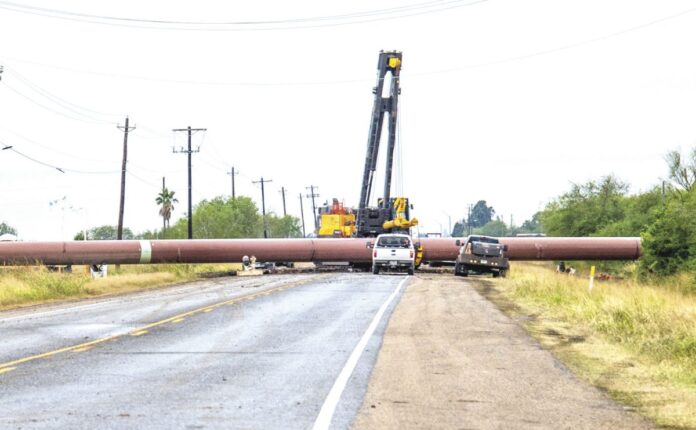BROWNSVILLE — It’s hard to miss for those who have driven S.H. 48 in the vicinity of the Brownsville Ship Channel during the past several months: Valley Crossing Pipeline, currently under construction to supply fracked natural gas to Mexico from the Eagle Ford Shale oil fields in Central Texas.
The $1.5 billion pipeline, being built by VCP parent company Enbridge Inc., is not related to liquefied natural gas projects proposed for the Port of Brownsville. Rather, it’s being built to supply Mexican power plants as that country transitions from coal and imported LNG in the wake of sweeping energy reforms.
The pipeline will receive gas from the Agua Dulce gas hub in Nueces County.
CFE, Mexico’s state-owned electric utility, awarded the pipeline construction contract to VCP in June 2016, and construction began last April. The 168-mile-long, 42-inch-wide pipeline is expected to be in service by October 2018, with a capacity of up to 2.6 billion cubic feet of natural gas per day, according to Enbridge spokesman Devin Hotzel, who responded to questions via email.
“To date, we have constructed and buried over 100 miles of pipeline,” he said. “Restoration of the surface has been completed through approximately 50 miles of that length. Construction activities will continue into the second quarter of 2018 before the construction in the (Rio Grande Valley) segment is complete.”
At its southern terminus several miles offshore at the U.S.-Mexico border, the pipeline will connect with the Sur de Texas-Tuxpan pipeline, also under construction. VCP is wholly owned by Valley Crossing Pipeline LLC, which is paying the entire cost of construction, Hotzel said, adding that CFE will pay for the rights to all the pipeline’s capacity.
The project features two compression stations, one in Aqua Dulce and one in Brownsville, necessary to push the gas through the pipeline.
The entire length of the pipeline will be underground, including segments where it passes under bodies of water, Hotzel said. Offshore, the pipeline will be buried beneath the seafloor, he said. To install the pipeline under bodies of water, VCP uses a method known as “horizontal directional drilling,” Hotzel said.
In addition to Mexico, VCP has been working with various other entities interested in receiving gas from the pipeline for local distribution and industrial markets, he said. To date, VPC has an agreement in place with at least one local distribution company. For monitoring purposes, the pipeline will include 143 miles of fiber optic cable.
“The pipeline will be remotely monitored and controlled real-time 24 hours a day, 365 days a year, from our pipeline control facility located in Houston,” Hotzel said.
In February, Canada-based Enbridge merged with Houston-based Spectra Energy Corp. (which originally won the CFE contract to build VCP), creating the largest energy infrastructure company in North America.





